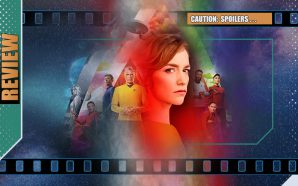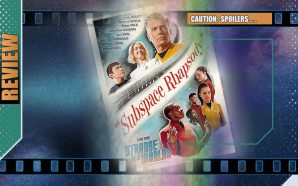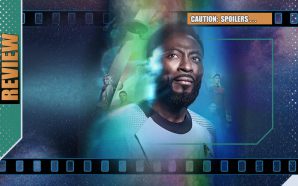The planet Hetemit-9 – a seemingly abandoned Illyrian colony – is something of an enigma. Though the Illyrian race possessed the technology and evolution to apply to be a member of the Federation, its attitude to genetic manipulation (banned in the wake of the Earth’s Eugenic Wars) made it an outsider and unable to join. But with less and less active communication with the outpost and frequent ion storms causing few opportunities to engage with them, there’s been a philosophical and physical barrier to proceeding.
When the Enterprise visits the area, there’s no sign of the planet’s inhabitants – but an incoming storm threatens to curtail the investigations of the landing party. Most make it back to the Enterprise, though it’s a close-call. Captain Pike and Science Officer Spock remain on the surface until the storm has receded.
But when dangerous incidents start happening aboard the Enterprise, with members of the returned landing party being driven to desperately seek more light and heat, it’s clear that something has contaminated the ship. Number One/Una sets out to find the answers, but in a race against time, will personal secrets and deceptions help or hinder progress?
*spoilers*
There’s some significant revelations in the latest Strange New Worlds. The fact that the events of the episode highlight the cost of choices made and bring to light (no pun intended) some major procedural and personal transgressions means this is more a character-piece than an action-outing – though the entry does manage to include a massive ion storm and ethereal creatures that the post-production department renders very effectively.
While Strange New Worlds continues to echo the kind of stories you might have seen on The Original Series, it also continues to tilt at them in a different way – with both the efforts of VFX and also in the evolution of more nuanced story-telling. Where TOS might have made its focus the predicament of its trapped Captain and away-mission crew, here Pike and Spock are largely the B-story to the main drama happening aboard the Enterprise. There’s a brief indication that Pike’s decision for he and Spock to be the last to be beamed off Illyria might be linked to his belief that his death won’t come for another decade, though – thankfully – it’s not writ large – and could be as much as simply good captaincy policy. Having to bunker down in the library and then being protected by (rather than attacked by) the transient ionic forms is a compact element of the episode’s themes about perceptions and consequences. The idea that these forms could be the original Illyrians whose efforts to do and then undo genetic manipulation led them to this fate is an open-ended and philosophical point.
The idea of a contagion aboard the Enterprise – and the efforts to analyse is origin and contain it- feel topical enough given COVID, though beyond the lockdown and the heightened stress it’s a metaphor that’s not over-played. It’s interesting how the spread affects the crew at different speeds. There may be some handwaving logic in those details, but the method of contamination being the amount of light in an area is a new variation on a theme, as is the fact that the contaminated are not being turned into ‘zombies’ out to kill others as much as driven towards powerful light and heat sources and only becoming violent to others when interrupted. There’s plenty of ways that the light addiction plays out, from a crewman (who initially looked very much like Dune‘s Timothy Chalamet) banging his head against an illuminated wall to Hemmer trying to beam in molten magma and Christina Chong’s La’an Noonien-Singh seeking to overload the warp core to cause a warm, fuzzy explosion.
Though the narrative thematically links the current and past actions of Una Chin-Reilly/ Number One (Rebecca Romijn) and Doctor M’Benga (Babs Olusanmokun) – each acting under different impulses – the fact that we have two characters who, by all Star Fleet regulations, could be stripped of their command positions, means that there’s a lot of important story pivots for just one outing. One can’t help feeling that however well the story presents the needs of the many over the needs of the one (overtly and obliquely), both stories and predicaments might have worked even better if they hadn’t come to a head at exactly the same time. Clearly, we have sympathies with both of the crew-members – both acting with the best of intentions and with no malice intended, but what of the fallout?
Though it speaks to innate problems with Star Fleet’s vetting procedures, Una lying about her true heritage feels less egregious as it goes to decisions made before her choice to join Star Fleet and with no examples of that history ever causing harm or danger to any of her crew-mates. She makes a compelling case when she speaks to the fact that though the Federation has good reason for making a stand against genetic enhancements (in the wake of the Eugenic Wars) there are also those who change their genetic code not for military or aggressive purposes, but to help explore those strange new worlds, adapting to the environments rather than making those adapt to them. It’s a difficult line in the sand and, as ever, the argument becomes about how dangerous technology can be when used badly rather than the tech itself. There’s still a question of just how much Una is enhanced – she has superior strength and some immunities, that much is for sure, but one wonders if she’s ever had to actively hide them before at a cost? It also causes friction when La’an finds out the truth and notes that she was made to feel ostracised when she was younger merely because of her ancestry (to the infamous Khan and his idea of creating genetic superiority) and a person like Una – whom she considered a friend – has deceived her.
On the other hand, M’Benga’s actions – driven by the very personal and medical need to forestall the death of his own child (and what reason could be more primal?) – feel they should have some sort of consequence. His actions (storing her in a pattern-buffer which, in the end, accidentally provided the contagion to jump systems) did, demonstrably, put the crew at risk and his deception was intentional, if never intended to cause harm. Una’s promise that she understands his motivation and will protect M’Benga’s research and child by giving them what amounts to a protected server status’ is a pure act of empathy between two people who made hard choices, but one does wonder if she’ll be keeping the wholesale existence of the pattern-buffered child and M’Benga’s deception to herself. More logically, she’d have to tell both the Captain and Hemmer (Bruce Horak) which would surely open up M’Benga facing more consequences than just regret.
Accepting that people should be judged by their actions rather than societal judgements about their heritage, Pike decides not to accept Una’s resignation, nor to actively inform Star Fleet (though – again – how far can that secret be maintained when key characters now know?) is a tribute to his bond with his First Officer. Mount and Romijn have great chemistry as colleagues and close friends that doesn’t simmer with the sexual variation that most shows insist upon and I’m finding myself more and more drawn towards the characters and the combination of their bonds as the series progresses.
Leslie Hope (now a go-to director and having just come off a string of Snowpiercer episodes) once again delivers the goods. Excepting a questionable bit of continuity (Una’s torn uniform, which might still have been a pragmatic change for the character to choose between scenes, but which still looks odd) and some of the scientific mumbo-jumbo used to conveniently ultimately wrap-up the dilemma, this is show with real attention to style and intent. This is the third entry in the new series and while not perfect, it’s proving an engaging, enjoyable experience and probably the best Trek in quite some time.

- Story8
- Acting8
- Directing8
- Production Design / VFX9












